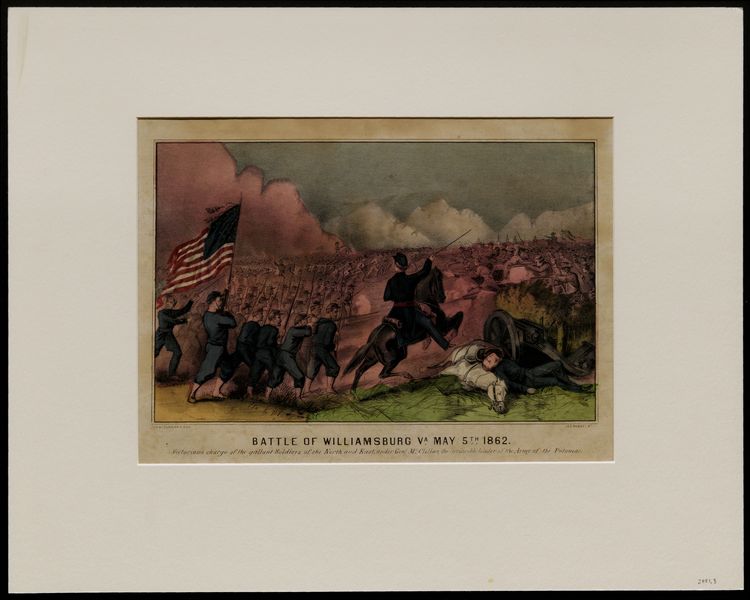Currier & Ives Battle of Williamsburg Va. May 5th 1862
High-resolution images are available to schools and libraries via subscription to American History, 1493-1943. Check to see if your school or library already has a subscription. Or click here for more information. You may also order a pdf of the image from us here.
A high-resolution version of this object is available for registered users. LOG IN
Gilder Lehrman Collection #: GLC02881.03 Author/Creator: Currier & Ives Place Written: New York, New York Type: Print Date: circa 1862 Pagination: 1 lithograph : col. ; 29.4 x 40.4 cm. Order a Copy
Hand colored lithograph published by Currier & Ives at 152 Nassau Street, New York. Print is mounted. Caption under the title reads: "Victorious charge of the gallant Soldiers of the North and East, under Genl. McClellan, the invincible leader of the Army of the Potomac." While the caption says this was a "Victorious charge," the Battle of Williamsburg was an inconclusive victory for the Army of the Potomac. Rows of Federal and Confederate troops are shown clashing in close combat, with a magenta hue dominating their depiction. The foreground shows several Union troops in blue uniforms, a solider carrying an American flag, an officer on horseback urging his troops forward, and a killed or wounded officer lying on the ground with his horse next to a cannon (no blood is depicted). See GLC02881.25 for a more varied coloration of the same lithograph.
In the first pitched battle of the Peninsula Campaign at Williamsburg, Virginia, nearly 41,000 Federals and 32,000 Confederates were engaged. Following up the Confederate retreat from Yorktown, General Joseph Hooker’s division encountered the Confederate rearguard near Williamsburg. Hooker assaulted Fort Magruder, an earthen fortification alongside the Williamsburg Road, but was repulsed. Confederate counterattacks, directed by Major General James Longstreet, threatened to overwhelm the Union left flank, until General Phil Kearny’s division arrived to stabilize the Federal position. General Winfield Hancock’s brigade then moved to threaten the Confederate left flank, occupying two abandoned redoubts. The Confederates counterattacked unsuccessfully. Hancock’s localized success was not exploited. The Confederate army continued its withdrawal during the night.
Citation Guidelines for Online Resources
The copyright law of the United States (title 17, United States Code) governs the making of photocopies or other reproductions of copyrighted material. Under certain conditions specified in the law, libraries and archives are authorized to furnish a photocopy or other reproduction. One of these specific conditions is that the photocopy or reproduction is not to be “used for any purpose other than private study, scholarship, or research.” If a user makes a request for, or later uses, a photocopy or reproduction for purposes in excess of “fair use,” that user may be liable for copyright infringement. This institution reserves the right to refuse to accept a copying order if, in its judgment, fulfillment of the order would involve violation of copyright law.
